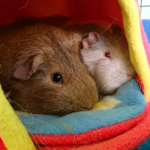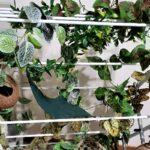
These little piggies look pretty comfy in their setup with soft bedding and plenty of tasty snacks for the trip home!

This box is specially made for rats and is complete with soft bedding, a hide and ventilation.

Sushi is always happy when there are snowpeas to munch on!
Small mammals such as guinea pigs, rats and mice are popular pets – and rightly so – they are wonderful little creatures! Unfortunately there are a number of health issues that plague our small mammal friends, as they often need to come into the vet for assessment. We recommend a general health check at least every 12 months, but every 6 months is more ideal for these small guys as health issues can arise very quickly! They should also come in to see us if you are concerned about anything e.g. appetite changes (not eating is an emergency for guinea pigs!), any signs of illness. Transport for these animals has the following specific requirements:
- All animals should be secure in their carrier, and not able to jump out to investigate the car or waiting room. This is particularly important for mice, who are capable of squeezing through very small spaces! Don’t forget that sometimes even guinea pigs decide they can jump! So an open box with short sides is not ideal.
- As these animals are all prey species, it is also important they feel safe and not stressed during their trip. So carriers should contain places to hide, or be covered with a towel to make them dark. It is helpful not to use solid hides with only one small entrance/exit point, as some creatures can be difficult to extract from here to examine in consult.
- A lot of small mammals naturally live in social groups and feel more comfortable if their companion accompanies them to the vet for moral support!
- Small mammals also eat very frequently, so ensuring they have some snacks for the car trip is a good idea, and also gives them something to keep them occupied.
These requirements can be met with commercial plastic carriers designed for small mammals, but also cat carriers and plastic tubs (with appropriate ventilation) can be used. Check out the pictures below for some examples and feel free to ask any questions about transporting your pet when you book your appointment on 07 3217 3533.



